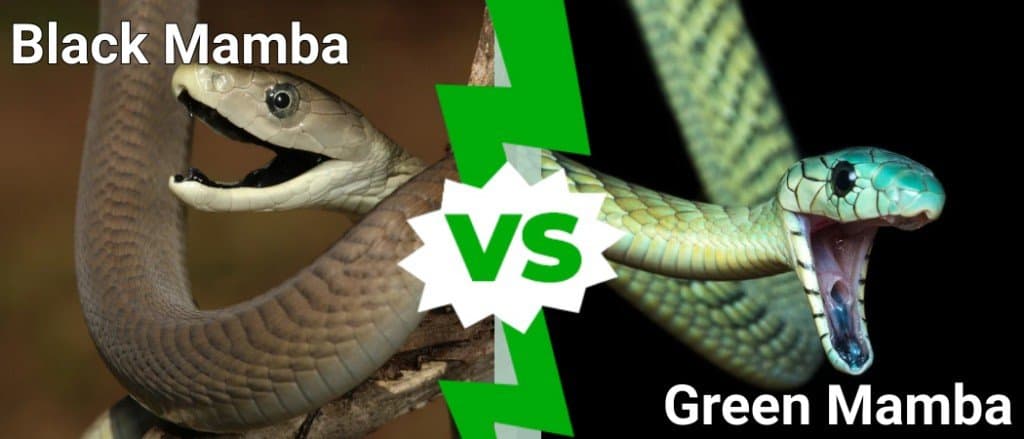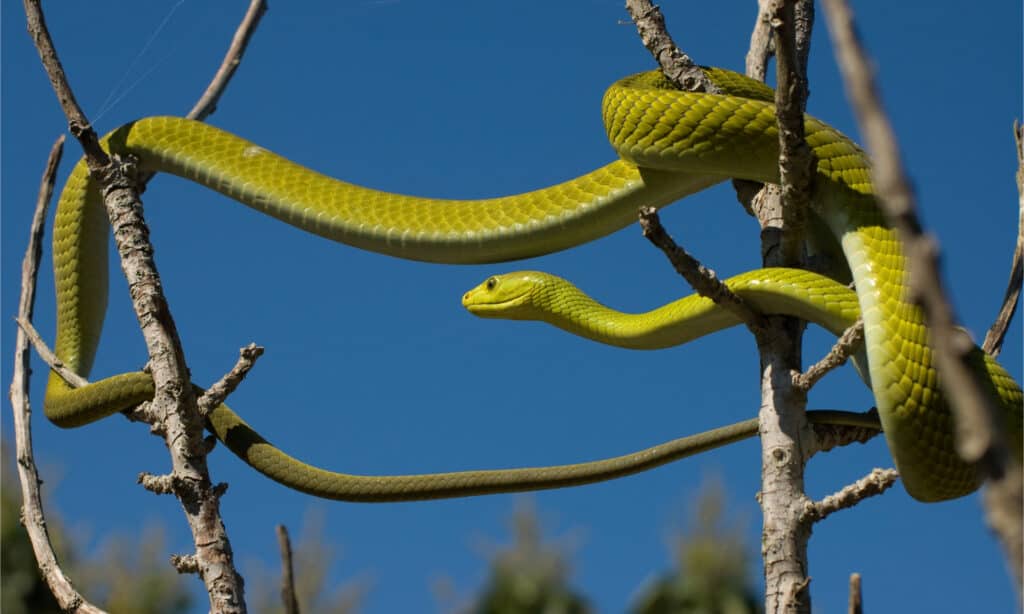
The post A Fascinating Look at Snake Milking appeared first on A-Z Animals.
Few experiences in wildlife handling are as nerve-wracking as snake milking. This mesmerizing activity isn’t just a spectacle; it’s vital work that powers lifesaving research, equips antivenom production, and broadens our understanding of medical science. Let’s watch an example of a brave and experienced handler extracting venom from one of the deadliest snakes in the world: the green mamba. Along the way, we’ll explain the process, the purpose, and the plan nature has for venomous reptiles like this in the ecosystem.
Milking a Mamba
Coyote Peterson has attracted nearly 22 million subscribers to his Brave Wilderness YouTube channel by taking viewers vicariously with him into wild and dangerous situations in nature that most of us would avoid at all costs. In this brief clip, he observes a handler milking a deadly green mamba. The handler observes that this snake is mainly arboreal and has long fangs for penetrating the plumage of birds that are one of its main prey. Coyote is impressed with how much venom the snake produces and that it seems to shoot out rather than just dripping. The video leaves us with some questions though.
What’s the Difference Between Black and Green Mambas?

Mambas live out in the rural parts of sub-Saharan Africa; there are two main kinds—black and green. The black mamba isn’t really black at all; it’s more of a dark gray or olive color, but the inside of its mouth is jet black. Green mambas, on the other hand, are different shades of light to bright green, allowing them to disappear into the treetops.
The black mamba (Dendroaspis polylepis) is Africa’s longest and fastest venomous snake, growing over 12 feet long and able to move over land in bursts of over 10 mph. It spends its time on the ground in savannas and rocky places. When it feels threatened, it lifts its front half, opens that pitch-black mouth, and hisses loud enough to make anyone in proximity step back.
Green mambas are smaller, thinner, and spend their lives up in the trees. Their bright scales make them almost vanish in the leaves, especially in the humid forests and coastal areas of eastern Africa. They hunt birds and small mammals quietly, relying on camouflage instead of confrontation. Both black and green mambas are extremely venomous.
How Dangerous Are They?

Eastern green mamba –
Dendroaspis angusticeps, one of the deadliest snakes in the world.
©Eric Isselee/Shutterstock.com
Mambas rank among the most dangerous snakes in the world, mostly because of their speed, potent venom, and quick defensive reactions. The black mamba has one of the fastest-acting venoms of any snake, a neurotoxin that shuts down the nervous system by blocking signals between the brain and muscles, causing paralysis and respiratory failure. Without treatment, death can occur in as little as 30 to 60 minutes, though modern antivenom and hospital access have drastically improved survival rates. Green mambas carry a similar venom but are far less aggressive, relying on camouflage rather than confrontation.
For comparison, mamba venom is faster-acting and deadlier than that of cobras or rattlesnakes, though snakes like the inland taipan technically hold more toxins in their venom drop for drop. In rural parts of Africa, dozens of deaths per year are linked to mamba bites, mostly from black mambas. Reliable numbers are hard to track as many bites happen in remote rural areas and go unreported. Despite their fearsome reputation, mambas usually strike only when threatened or cornered.
Why Are There Venomous Snakes Anyway?

The eastern green mamba’s coloration is an adaptation to living in trees.
©Heiko Kiera/Shutterstock.com
Mambas are not an endangered species, but if they were, it might be hard to get people to donate to save them. No love is lost on a snake that’s fast, climbs trees, and kills people. If they disappeared from the environment though, it would severely disrupt the ecosystem.
The speed of the mamba and its lunging distance means it can capture fast animals, like birds, in the tree canopy. Fast-acting neurotoxins in the venom paralyze energetic prey quickly, preventing escape. Nonvenomous snakes don’t have those kinds of advantages. This means without the population control provided by an apex predator like the mamba, prey would become overpopulated, rippling through food chains and creating an impact on other species. Slower birds, for example, might find their food sources disappearing and begin to die out.
Why Are Venomous Snakes Milked?

Snake venom is used for research and to produce antivenom.
©Ton Ponchai/Shutterstock.com
Venomous snakes are “milked” — meaning their venom is carefully extracted — for antivenom production and research. The most important use is making antivenom, the treatment that saves lives after snakebites. Scientists inject tiny, controlled amounts of venom into animals like horses or sheep, which then build antibodies. Those antibodies are later purified from the animal’s blood and turned into antivenom serum.
Venom is also valuable for medical research. Its complex mix of proteins and enzymes helps scientists study blood pressure, nerve signals, and clotting. Some drugs for heart disease and pain actually came from snake venom compounds.
Mamba venom is of particular interest to researchers. Unlike other types of venom that damage tissue or clot blood, mambas use pure neurotoxins that target the nervous system. Scientists study these compounds to better understand how nerve signals work and to develop drugs that can block pain, control seizures, or treat neurological disorders. Some components of mamba venom have even shown potential for creating non-addictive painkillers.
How is Milking Done?

Milking involves inducing a snake to bite a membrane over a glass to collect venom.
©Ton Ponchai/Shutterstock.com
Snake milking is done by trained handlers in controlled laboratory settings. The handler first uses a hook or tongs to restrain the snake, keeping its body supported while securing the head just behind the jaws. The snake is then induced to bite a soft membrane stretched over a sterile container — often a thin film of plastic or rubber covering a glass cup. When the fangs pierce the membrane, the jaw muscles engage, the glands contract, and venom releases automatically into the container.
The amount collected depends on the species, size, and health of the snake. The venom is then freeze-dried or refrigerated for later use in making antivenom or for laboratory study. It’s a precise, practiced procedure — dangerous if done carelessly, but routine for professionals.
Does It Hurt the Snake?

Professionals are able to milk snake venom without hurting the animal.
©Venom Diaries with Bill Collett – Original
When performed correctly, milking does not harm the snake. Ethical facilities maintain high standards to ensure the welfare of their animals, as stressed or injured snakes produce unreliable venom samples. A skilled handler avoids excessive pressure, preventing damage or exhaustion. Afterward, snakes are returned to their enclosures, offered water and food, and monitored carefully.
Venom glands replenish naturally over time. Depending on species and health, a snake may be milked every few weeks. Over-milking is avoided because venom production is metabolically demanding. Proper spacing between sessions ensures that snakes remain healthy and the samples consistent.
Can You Safely Drink Snake Venom?

Snake wine is a dangerous drink made of venom mixed with alcohol.
©Chantal de Bruijne/Shutterstock.com
Many believe venom can be swallowed safely, thinking it must enter the bloodstream to be dangerous. While that is partly true, it’s not a risk worth taking. The stomach can neutralize venom proteins, but even a small cut in the mouth or digestive tract can allow toxins to enter circulation. Once in the bloodstream, venom acts as if it were injected, leading to paralysis or organ failure. Reports exist of people becoming seriously ill after consuming “snake wine,” in which venom is dissolved in alcohol. Reactions can include shock, allergic collapse, and internal bleeding. The only safe interaction with venom is through scientific study—not folklore or daring stunts.
Respecting the Danger and the Potential
Snake milkers face constant risk. A black mamba can strike multiple times in seconds, each bite delivering enough venom to kill several adults. Yet most professionals complete their careers without incident thanks to steady focus and respect for the animals. They work not from recklessness but from fascination, transforming deadly biology into medicine. Snake milking stands as a reminder that even the most dangerous creatures hold secrets that can not only kill, but potentially heal.
The post A Fascinating Look at Snake Milking appeared first on A-Z Animals.
October 19, 2025 at 06:02PMDrew Wood
.jpeg)
.jpeg)

0 Comments